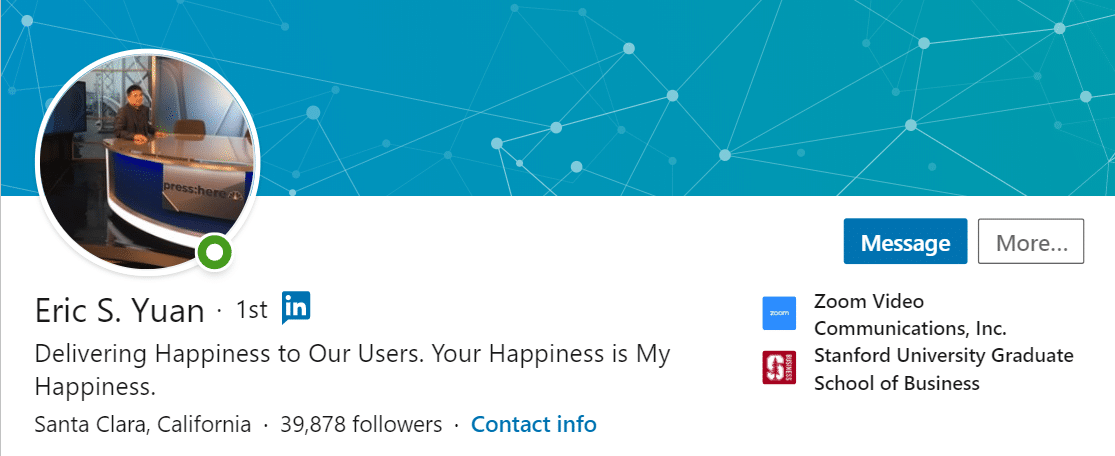Last week I saw three corporate slogans for Zoom that echo the words, ‘We Deliver Happiness.’ One of these was directly on the LinkedIn Profile of Eric S. Yuan, Zoom’s Founder and CEO. The next day I saw the below eye-catching banner at an airport. I recall thinking to myself that this is one of the most creative marketing ideas I have ever seen. To tie the word ‘happy’ to the everyday web-conferencing activities that we are all engaged with — is a creative way to make the feeling of Zoom fatigue more appealing.



Reflecting on using ‘happy’ alongside technology solutions reminded me that happiness is a great feeling. However, happy is also very temporal and elusive. My mind quickly traveled over the past 10-years on the many uses of technology. In this quick mind-travel, I was amazed at how much good has come from advancements in technology. These technological advancements have sped up language translations, helped blind people see, helped disabled individuals walk, cured numerous diseases, eradicated polio, and most recently helped a 17-year old student-intern at NASA discover a new planet. Cray Research also announced the deployment of the first Exascale supercomputer, which will be delivered to Oak Ridge National Laboratory and outperform the combined calculating speed of the current fastest 160 supercomputers.
The list of advancements and discoveries could go on-and-on. The potential for this much computing power, invention, and innovation is simply indescribable. However, the intentional persuasion to be ‘happy’ about all these advancements may be just as elusive as the term ‘happy’ itself. I believe we be must be more intentional with the technologies entrusted to civilization, lest we are misled with the next generation of technological feats and accomplishments.
The slogan by Zoom of creating ‘happy’ is an impressive statement, yet is only scratching the surface of the real breakthroughs the technology can bring forth. There is indeed a renaissance with people who grasp the profound challenges humanity faces; and how technology creates a different world than we know today.
The concept of creating a happy environment, service, or even world populace is in vogue. In 2019, former Google executive Mo Gawdat created an organization called One Billion Happy.
The premise behind this initiative of creating one billion happy people has to do with the emergence of artificial intelligence. The foundation of this organization has tremendous potential to help force a happy environment or society. Unfortunately, the objective of creating happy people is still elusive and unmeasurable. As the old saying goes, ‘Many people climb a ladder only to get to the top and find out that the ladder has been leaning against the wrong building.’ The premise for trying to create one billion happy people makes sense when you consider that artificial intelligence can only replicate the behavior of people, things, or machinery. The intent to create happiness is so that artificial intelligence will not replicate the perceived current behavior of people. This perceived current behavior includes hatred, selfishness, bigotry, prejudice, racism, anger, and political bias. If artificial intelligence lives up to its true systemic nature, it will learn the current behavior of modern-day humanity. I give Mo Gawdat a lot of credit for this endeavor of attempting to switch the behavior towards happiness, as it is better than the current state. However, there may be a few different attributes other than happiness hidden within humanity that can be measured, and create an even more systemic change in our society. These may include joy, peace, love, hope, and faith.
Artificial intelligence can watch, observe, record, and replicate the patterns that our human society is performing and behaving like. The ability to videotape, record, archive human behaviors through artificial intelligence is a breakthrough. The breakthrough occurs as our civilization can hear, see, observe, and analyze what we truly look and sound like. The most significant forms of self-change are when people finally see what they sound, look, and behave like. I realize that we do not need technology to step back and see, hear, observe, and analyze what we have become. This analysis is truly what faith, hope, and love are all about. Unfortunately, many people have become delusional and unaware of the simplicity of joy — which develops unity, peace, faith, hope, and love.
If I wake up each morning feeling happy, it is a completely different feeling than waking up full of joy. Happiness may be defined for each one very differently, such as — do I have enough cars, money, homes, friends, knowledge, college degrees, etc. Joy, on the other hand, is easy to see and easy to measure as it is a state of heart and mind that learns to be content no matter what things I possess or don’t possess. Discovering the joy of being content with any circumstance allows me to express peace, faith, hope, and love. In essence, joy becomes my inner strength. May I suggest we will get far more inner change and societal change with human joy than just happiness.
My premise for this article is to make a statement that technology is nothing more than a modern way to eventually manifest how people think, act, and behave. If the outcome of technology is merely happiness, we may be very disappointed. One of the most recognize songs in American history is the 1971 song ‘I’d like to teach the world to sing’. The song was written on behalf of Coca-Cola to align the message of ‘perfect harmony’ with their sugar water, called Coca-Cola. In 2020, Zoom and One Billion Happy are aligning ‘Happiness’ with the use of technology. In both cases, the marketing is clever and works for a few years, yet the pain within our society has never been greater. Technology needs to aid in attributes that accelerate way beyond happiness.
May I call upon every technologist, visionary, and technology company to look well-beyond the vision of making people happy. We have the ability with data science, the Internet-of-Things, 5G, the fastest supercomputers in the world, to help people see that there are far greater attributes than just being ‘happy’.
I am pleased to report that two organizations have accelerated well beyond ‘happy.’ Unite714, has organized a movement that brings ‘unity’ across the globe to have people pray for the world in ways that far exceed happiness. They are now bumping up against the first billion people to gather and assemble for a more significant cause than ‘happy’. They have united 889 million individuals around the world as they leverage the latest technologies. Shekhar Kallianpur, a visionary in Mumbai India started a movement called the 4AM Challenge, Billion Home Altars well before COVID-19. Ironically, this vision allowed hundreds of millions in India to be prepared for a season of quarantine.
Whether it is One Billion Happy, Unite714, or One Billion Home Altars it is clear that there are a growing number of organizations stretching the use of technology to virtually reach billions of people with technologies like Zoom. It behooves all of us to think through how each organization will define and impact how people are stretching humanity to accelerate past ‘happy’ into life-changing attributes such as peace, unity, love, hope, and faith.




